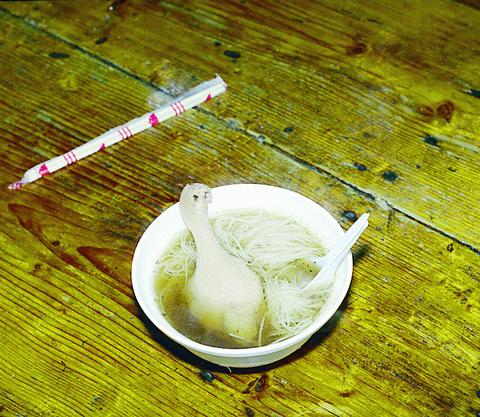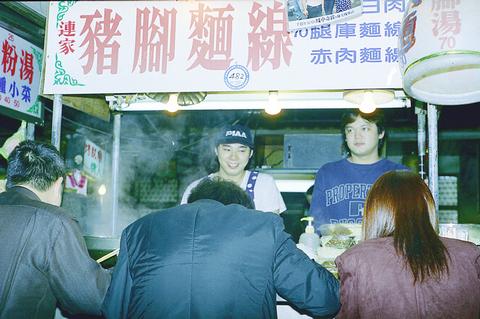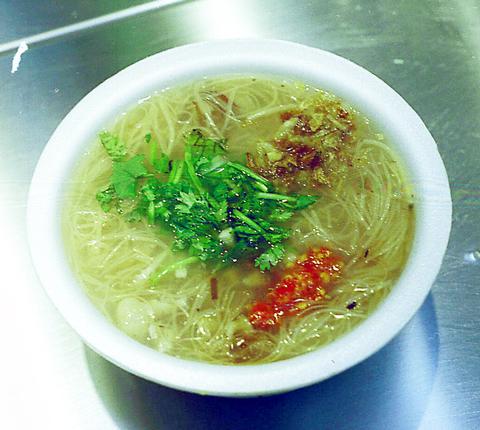Ah Hsin Noodles
(阿鑫麵線)

PHOTO: IAN BARTHOLOMEW
8, Lane 39, Shita Rd.,(北市師大路39巷8號), tel:(02)2363-3695. Open:3pm-10pm; Average meal:NT$50; No English menu; no credit cards.
Rediscovering fundamentals is what some of the best cooking is about, and for Chen Shao-hsin (陳紹鑫), who has traveled around Taiwan tasting hundreds of versions of a single Taiwanese noodle dish, he has settled on a recipe and has no intention of changing it.

PHOTO: IAN BARTHOLOMEW
Mian hsian (麵線), a thread-thin noodle made from wheat floor, is served in a wide variety of dishes, one of the most popular being with pig's intestines. It is a dish available in thousands of roadside stalls, and is generally remarkable for its strong flavor, usually the product of large quantities of MSG.

PHOTO: IAN BARTHOLOMEW
Ah Hsin, who has manufactured electrical toys and raised dogs commercially has become a fixture of the Shita night market over the last 11 years. Located outside a Japanese knick-knack store owned by his mother, Ah Chung's polished stainless steel stand looks more hygienic than the usual street-side stall. He is dressed in a dapper chef's jacket and cap, which looks attractively incongruous.
Only one dish is served at Ah Hsin's -- you can choose between a large bowl or a small bowl of mian hsian, with or without chili. The chili, which is homemade, has a fresh sharpness that is very appealing. Another personal addition is the use of deep fried onion chips, which add another level of flavor.
"The stock is made simply by boiling big pork bones," Ah Hsin says with pride. "We don't add any MSG." His secret is simple: the use of fresh ingredients and avoidance of all artificial coloring and flavoring. "At many places, the soup is an attractive red color, but that's just artificial coloring," he said. Indeed, the soup is a lighter color than one usually finds, but there is a freshness to it that is often lacking at other stalls.
"I make five cauldrons of the noodles every day. When it's sold out I close up," Chen said. The steady stream of customers coming by his stall, many of them regulars who enjoy a bowl of his thin noodles with intestines two or three times a week, attests to the popularity of his simple formula.
Cheng Yuan Tzu Tang Gui Duck
(正元祖當歸鴨)
42 Ta-an Rd., Sec. 1 (北市大安路一段42號), tel:(02)2772-9992. Open:Noon to 11pm; Average meal:NT$100; no English menu; no credit cards.
Tang gui (
When Cheng Yuan Tzu first opened, it specialized in tang gui dishes -- soup with mian hsian noodles and meat. "We also used to serve mutton and pig's foot with tang gui," said Tsai Ching-rong (蔡青蓉), the shop's proprietor. "But our tang gui duck was so popular we simply dropped the other dishes. In our heyday we used to sell over 100 ducks a day."
One bite into the tender duck flesh in the simple house specialty, tang gui duck, is enough of an explanation. "This is because of the way we prepare the meat," Tsai said. "First we cook it in the tang gui soup until it is 90 percent cooked. After that we chop it up and then let it simmer until cooked through. This way we ensure the meat is tender."
The tang gui soup, which has a sweet tanginess, is also the result of long experience. "You have to get the proportions exactly right," Tsai said. "When other people make it, it just doesn't taste the same." The balance between the medicinal herbs and the meat is what makes the soup so delicious. And the thin mian hsian noodles are handmade, so that even after a long time in the pot they remain firm and chewy.
Lian Family Pig's Trotter Noodles
(連家豬腳麵線)
Opposite 66 Raoho St.(饒河街) in the Raoho Street night market (饒河街觀光夜市), no telephone. Open:5:30pm-12:30am; Average meal:NT$70; no English menu; no credit cards.
Talk of pig's trotters and most people immediately think of congealed lumps of gelatinous skin and fat, often blackened with syrupy soy sauce. For some this is pig heaven, but for others, just looking is enough to take away their appetite.
The Lian family recipe for preparing pig's trotters is an ideal way to become aquatinted with this important Chinese dish -- pig's trotters with mian hsian noodles -- which is eaten at many important social events as a symbol of longevity and good fortune.
Lian An-yu (連安裕) is the second generation to run this inconspicuous stall which is almost overwhelmed by the anarchy of awnings and flashy stalls and shops around it. This doesn't prevent a steady stream of customers filling its 10 or so seats or carrying the food out. The stand has held its place in this bustling night market for nearly 10 years.
The mian hsian used in the stall's signature dish are pure white. The ingredients, whether you select trotters, shoulder meat with skin or lean meat, all are a creamy white. For first timers, the shoulder meat with skin is recommended, which, despite the thick layer of fat, does not taste the least bit oily.
The stock, which is made from trotters, rice wine, ginger and a secret mixture of Chinese medicinal herbs, makes a nutritious soup, with plenty of calcium and gelatins. The stall also offers cold noodles with its own special sesame and garlic sauce ideal for hot evenings.

The Taipei Times last week reported that the rising share of seniors in the population is reshaping the nation’s housing markets. According to data from the Ministry of the Interior, about 850,000 residences were occupied by elderly people in the first quarter, including 655,000 that housed only one resident. H&B Realty chief researcher Jessica Hsu (徐佳馨), quoted in the article, said that there is rising demand for elderly-friendly housing, including units with elevators, barrier-free layouts and proximity to healthcare services. Hsu and others cited in the article highlighted the changing family residential dynamics, as children no longer live with parents,

It is jarring how differently Taiwan’s politics is portrayed in the international press compared to the local Chinese-language press. Viewed from abroad, Taiwan is seen as a geopolitical hotspot, or “The Most Dangerous Place on Earth,” as the Economist once blazoned across their cover. Meanwhile, tasked with facing down those existential threats, Taiwan’s leaders are dying their hair pink. These include former president Tsai Ing-wen (蔡英文), Vice President Hsiao Bi-khim (蕭美琴) and Kaohsiung Mayor Chen Chi-mai (陳其邁), among others. They are demonstrating what big fans they are of South Korean K-pop sensations Blackpink ahead of their concerts this weekend in Kaohsiung.

Taiwan is one of the world’s greatest per-capita consumers of seafood. Whereas the average human is thought to eat around 20kg of seafood per year, each Taiwanese gets through 27kg to 35kg of ocean delicacies annually, depending on which source you find most credible. Given the ubiquity of dishes like oyster omelet (蚵仔煎) and milkfish soup (虱目魚湯), the higher estimate may well be correct. By global standards, let alone local consumption patterns, I’m not much of a seafood fan. It’s not just a matter of taste, although that’s part of it. What I’ve read about the environmental impact of the

Oct 20 to Oct 26 After a day of fighting, the Japanese Army’s Second Division was resting when a curious delegation of two Scotsmen and 19 Taiwanese approached their camp. It was Oct. 20, 1895, and the troops had reached Taiye Village (太爺庄) in today’s Hunei District (湖內), Kaohsiung, just 10km away from their final target of Tainan. Led by Presbyterian missionaries Thomas Barclay and Duncan Ferguson, the group informed the Japanese that resistance leader Liu Yung-fu (劉永福) had fled to China the previous night, leaving his Black Flag Army fighters behind and the city in chaos. On behalf of the